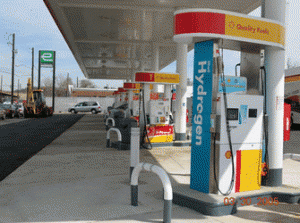 Hydrogen fuel cell vehicles have been the subject of skepticism for years – always waiting to break through but stuck in the planning phase due to excessive production costs for automakers and lack of fueling infrastructure for vehicle owners. In late 2013, automakers (especially Toyota, Honda, and Hyundai) committed to manufacturing and marketing new fuel cell vehicles within the next two years. Now, the fueling infrastructure is getting a boost, and it should benefit from having a prominent automotive executive playing a lead role.
Hydrogen fuel cell vehicles have been the subject of skepticism for years – always waiting to break through but stuck in the planning phase due to excessive production costs for automakers and lack of fueling infrastructure for vehicle owners. In late 2013, automakers (especially Toyota, Honda, and Hyundai) committed to manufacturing and marketing new fuel cell vehicles within the next two years. Now, the fueling infrastructure is getting a boost, and it should benefit from having a prominent automotive executive playing a lead role.
FirstElement Fuel Inc. just won a $27.6 million grant from the California Energy Commission that will bring 19 more hydrogen fueling stations to the state. Joel Ewanick, a former Hyundai and General Motors chief marketing executive, serves as CEO at FirstElement Fuel, and says that once these stations are deployed, fuel cell vehicles will be able to drive anywhere in the state without running out of fuel.
These 19 locations will be assembled at existing filling stations; FirstElement Fuel is ordering the fueling equipment, which will take months to build and install, Ewanick said. They’re expected to be up and running by the fall of 2015 or sooner. The stations will need to have the fuel delivered at first, but can eventually produce hydrogen on site. Having more stations up and running soon will help Hyundai as it launches its 2015 Tucson Fuel Cell this spring; Honda will roll out its new fuel cell car this year and Toyota said it will introduce its fuel cell model in 2015. Toyota has felt strong enough about the fueling infrastructure to provide FirstElement Fuel with an investment of at least $7.2 million.
California announced last week that it is funding $46.6 million in grants for 28 hydrogen stations as part of its commitment to zero emission vehicles. Northeastern states are likely to follow suit with hydrogen fueling, Ewanick said. New York, Connecticut, Massachusetts, Maine, Rhode Island, Vermont, and New Jersey previously adopted California’s clean air standards.
Ewanick had served as global marketing chief at GM and was ousted in the summer of 2012 for the handling of a controversial sponsorship deal with English soccer club Manchester United. Ewanick played a key role in marketing the Chevrolet Volt (and accepted the Green Car of the Year Award for the Volt at the LA Auto Show in late 2010); he also served as interim chief of global sales and marketing for Fisker Automotive. Ewanick appears to be fascinated with clean, advanced vehicle technologies and their economic opportunities – as are many other people in the automotive and transportation sectors.
The U.S. Department of Energy (DOE) has established research and development projects in the past two years with automakers, fuel station providers, and its research centers. Most recently, DOE launched H2FIRST, a collaboration with Sandia National Laboratories and National Renewable Energy Laboratory; the project will focus on accelerating the design and construction of hydrogen fueling stations. Currently, there are only 11 hydrogen stations in the US (10 in California and one in Columbia, SC). Forty seven are actively in development in California, according to the California Fuel Cell Partnership. Several European Union nations are deploying hydrogen stations (with Germany playing the leading role); Japan and South Korea have been committed to the vehicles and fueling stations longer than other nations, and now have several hydrogen fueling stations set up.


